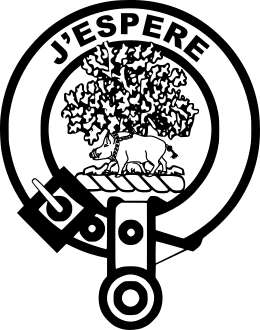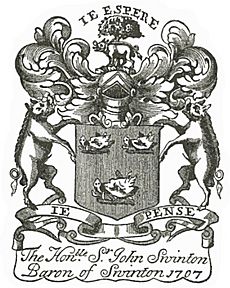Clan Swinton facts for kids
Quick facts for kids Clan Swinton |
|
|---|---|

Crest: A boar chained to a tree
|
|
| Motto | J'espere ("I hope") |
| Profile | |
| Region | Lowlands |
| District | Berwickshire |
| Chief | |
 |
|
| Rolfe William Swinton of that Ilk | |
| Chief of the Name and Arms of Swinton. | |
| Seat | New York, United States. |
| Historic seat | Swinton House, Berwickshire |
Clan Swinton is a historic Scottish clan from the Scottish Lowlands. The Swinton family has a long and interesting history. They are known for their bravery and for being one of Britain's oldest land-owning families.
Contents
History of the Swinton Clan
How the Swinton Name Began
The Swinton family likely came from the Anglo-Saxon people. They might be related to important leaders from the old kingdom of Northumbria. This kingdom was located across what is now the border between Scotland and England.
A popular story says the family got their name because they were brave enough to clear the land of wild boar. The boar on their family crest (a special symbol) hints at this legend. However, the name probably comes from a place. The village of Swinewood in Berwickshire was given to Coldingham Priory in 1098. This happened after the Norman Conquest in England.
Around 1136, a man named Ernulf de Swinton received a special document. It was one of the first private land agreements in Scotland. David I of Scotland confirmed Ernulf's ownership of his land. This document called Ernulf a Miles, which means he was the first recorded Knight in Scotland. This shows how important he was.
The documents also mention Ernulf's father, grandfather, and great-grandfather. His great-grandfather, Eadulf, may have received the land from his cousin, Malcolm III of Scotland. This was a reward for helping Malcolm against King Macbeth. If this is true, the Swinton family is one of the very few in Britain. They can trace their land ownership and family line back to before the Norman Conquest. This makes them one of the oldest noble families in the country!
The Swinton clan has also held important land titles. These include the Baronies of Swinton and Cranshaws.
Fighting for Scottish Independence
In 1296, Henry de Swinton and his brother, William, signed the Ragman Rolls. This meant they promised loyalty to Edward I of England. But later, Henry's great-grandson, Sir John Swinton, became a famous soldier and leader. He served under Scottish Kings Robert II of Scotland and Robert III of Scotland.
In 1388, Sir John was a commander at the Battle of Otterburn. The Scottish forces won this battle. Sir John had a son, Sir John Swinton, 15th of that Ilk, with his third wife, Princess Margaret.
Battles in France
Sir John Swinton, 15th of that Ilk was also a brave warrior. He fought in France during the Hundred Years' War. At the Battle of Baugé, he is said to have killed the Duke of Clarence. The Duke was the brother of Henry V of England. This event is even mentioned in a poem by Sir Walter Scott. Sadly, Sir John was later killed in 1424 at the Battle of Verneuil in France.
Important Figures in Recent History
In 1567, Sir John Swinton was one of the Scottish leaders. He signed an agreement to protect the young James VI of Scotland. This was against the Earl of Bothwell, who married James's mother, Mary, Queen of Scots.
In 1640, Sir Alexander Swinton, the 22nd chief, became the sheriff of Berwickshire. He had many children. His second son, also named Alexander Swinton, became a judge in Scotland in 1688. He was known as Lord Mersington.
His oldest son, John, was a colonel. In 1651, he was captured at the Battle of Worcester. His brother, Robert, died trying to capture Oliver Cromwell’s flag. In 1655, John was chosen by Oliver Cromwell to help rule Scotland. John was considered Cromwell's most trusted man in Scotland. Because of his close ties to Cromwell, John was later put on trial for treason in 1661. He avoided execution but lost his lands and was jailed for six years.
Later, John's brother, Sir John, became the 25th Laird of Swinton. He had a successful career as a merchant in Holland. He returned to Scotland after the Glorious Revolution of 1688. This event brought William of Orange and Queen Mary to the throne.
Sir John served in both the Scottish Parliament and later the British Parliament. He was also the President of the Committee for Trade in Scotland. Another John Swinton, the 27th Laird, became a judge in 1782. He was known as Lord Swinton.
The modern Swinton family has also produced many famous people. Captain George Swinton was a high-ranking official in Scotland. He was the Lord Lyon King of Arms. Major-General Sir Ernest Dunlop Swinton helped develop and train soldiers to use tanks in World War I. Alan Archibald Campbell-Swinton is often called the "father of modern television." The famous actress Tilda Swinton is also a great-granddaughter of Captain George Swinton.
Clan Chief
The current chief of Clan Swinton is Rolfe William Swinton. He is the 36th person to hold this title. His son, Maxim Jasper Swinton, is next in line to become the 37th chief.
Clan Castles
The Swinton clan has owned several important castles and estates throughout history:
- Swinton House in Swinton, Berwickshire, is a beautiful mansion built around 1800. It stands where an older castle once was. That castle was destroyed by fire in 1797. The Swinton family owned these lands since the 11th century. Today, the main Swinton chiefs live in New York, USA.
- Cranshaws Castle was owned by the Swintons from 1400 to 1702.
- Kimmerghame House and its lands were bought by Archibald Swinton in the 1700s. A new house was built there in 1851. It was badly damaged by fire in 1938 and only partly rebuilt. Until 2018, the owner was Major-General Sir John Swinton. He was the father of the actress Tilda Swinton.
- Little Swinton near Coldstream was once the site of a Swinton castle. The English destroyed it in 1482.
- Mersington Tower near Greenlaw was a castle first held by the Clan Kerr and then by the Swintons. It was burned by the English in 1545.
- Stevenson near Peebles was a tower house owned by the Swintons. It passed to the Clan Sinclair family in the 1600s through marriage.


